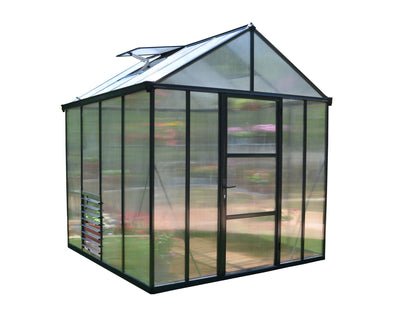How to Keep a Greenhouse Warm in Winter Without Electricity
A greenhouse allows gardeners to grow plants all year, but keeping it warm in winter without relying on electricity can be a challenge. Fortunately, there are cost-effective, eco-friendly methods that help retain heat and protect plants during colder months.
Polycarbonate greenhouses are particularly effective at maintaining stable temperatures, thanks to their excellent insulation and light diffusion. By using natural heat sources, thermal mass, and insulation techniques, you can create a warm and stable growing environment without the need for electric heaters.
This guide covers the best low-cost, sustainable ways to keep a greenhouse warm in winter, ensuring healthy plant growth even in the coldest months.
1. Maximise Heat Retention with Insulation
The first step to keeping a greenhouse warm is preventing heat loss. Even without artificial heating, proper insulation helps trap warmth and create a stable temperature inside the greenhouse.
Use Bubble Wrap for Extra Insulation
One of the simplest ways to insulate a greenhouse is by lining the inside with horticultural bubble wrap. This:
-
Traps heat by creating a layer of air between the greenhouse panels and the inside space.
-
Allows light to pass through, so plants continue receiving sunlight.
-
Prevents cold drafts, keeping the internal environment stable.
For polycarbonate greenhouses, which already offer superior insulation, bubble wrap adds an extra layer of protection, especially for extremely cold nights.
Seal Any Gaps to Reduce Heat Loss
Even small gaps around doors, vents, or panels can let cold air in and warm air out. Check for:
-
Loose greenhouse panels that need securing.
-
Gaps around doors or windows, which can be sealed with weather stripping.
-
Ventilation openings that can be temporarily reduced in size during winter.
A well-sealed greenhouse retains natural warmth more effectively, reducing the need for additional heating solutions.
2. Use Thermal Mass to Store and Release Heat
Thermal mass refers to materials that absorb heat during the day and release it slowly at night, helping maintain consistent temperatures inside the greenhouse.
Water Barrels for Passive Heat Storage
Water is one of the best natural heat-retaining materials. Placing large, dark-coloured open water tanks inside the greenhouse allows them to:
-
Absorb sunlight and heat during the day.
-
Slowly release warmth overnight, preventing sudden temperature drops.
For best results, position water tanks along the back wall or near plants to provide even heat distribution.
Stone, Brick, or Concrete Pathways
Hard materials like stone, brick, or concrete also work as thermal mass, storing heat from the sun and radiating it back into the greenhouse at night. If possible, consider:
-
Adding stone or brick walkways inside the greenhouse.
-
Using raised garden beds with stone or brick walls to retain and release heat.
These materials naturally regulate temperatures, helping prevent sudden frost damage.
3. Compost for Natural Heat Generation
Compost piles generate heat as organic materials break down, making them an excellent natural heat source for greenhouses.
How to Use Compost to Heat a Greenhouse
-
Place a compost bin inside the greenhouse to release heat gradually.
-
Use hot composting methods with nitrogen-rich materials like grass clippings and kitchen scraps for faster heat production.
-
Position compost near growing areas to warm soil and air naturally.
Compost not only keeps a greenhouse warm but also provides nutrient-rich material for healthy plant growth.
4. Create a Wind Barrier to Reduce Heat Loss
Cold winds can rapidly lower greenhouse temperatures, making it harder to maintain warmth. A wind barrier helps block harsh winter winds and keeps the interior more stable.
Best Windbreak Options for a Greenhouse
-
Hedges or Shrubs – Natural wind barriers that also improve insulation over time.
-
Fencing or Trellis Panels – Provides instant protection from strong winds while allowing airflow.
-
Stacked Straw Bales – An excellent short-term solution that helps block wind and adds insulation.
Positioning a windbreak on the side facing prevailing winds reduces heat loss significantly, keeping the greenhouse environment warmer and more stable.
5. Use Cold Frames Inside the Greenhouse for Extra Protection
For particularly delicate plants, adding cold frames inside the greenhouse provides an extra layer of insulation.
How Cold Frames Help in Winter
-
Create a microclimate that traps warmth around plants.
-
Reduce exposure to cold drafts.
-
Protect seedlings and tender plants without needing electricity.
Small wooden or polycarbonate cold frames placed directly over plants act as mini-greenhouses within the greenhouse, offering additional frost protection.
6. Cover Plants with Horticultural Fleece or Row Covers
If extreme cold is expected, horticultural fleece, row covers, or cloches provide an easy way to retain heat directly around plants.
-
Fleece covers trap heat and prevent frost damage.
-
Plastic cloches or domes help individual plants retain warmth.
-
Row covers over raised beds keep soil temperatures higher overnight.
Using covers in combination with a well-insulated polycarbonate greenhouse ensures optimal growing conditions, even in winter.
7. Maximise Sunlight Exposure During the Day
Even in winter, sunlight is the best free heat source, so optimising greenhouse placement and cleaning panels regularly ensures maximum warmth.
How to Get the Most Sunlight in Winter
-
Face the greenhouse toward the sun – A north-facing position captures the most light in New Zealand’s winter.
-
Keep greenhouse panels clean – Dirt or debris can block sunlight, reducing heat absorption.
-
Use reflective surfaces inside the greenhouse – Placing white stones or reflective sheets near plants helps redirect light and warmth.
By taking advantage of natural sunlight, a greenhouse can stay significantly warmer during the day, reducing heat loss at night.
Keeping a greenhouse warm in winter without electricity is entirely possible by using insulation, thermal mass, compost heating, and strategic plant protection. A well-designed polycarbonate greenhouse already provides excellent heat retention, and by implementing these additional methods, you can ensure a stable, productive growing environment all winter long.
By combining natural heating techniques and insulation, you can enjoy a thriving greenhouse without relying on expensive heating solutions.
















